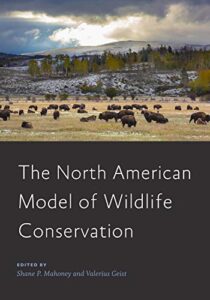 As I began Technical Week by looking at the subject of international wildlife management, I thought I’d get a little more focused with this next Newly Noted entry and consider the approach used in North America.
As I began Technical Week by looking at the subject of international wildlife management, I thought I’d get a little more focused with this next Newly Noted entry and consider the approach used in North America.
While it may not be widely known outside of professional circles, the ideas and techniques that have been developed in North America for the conservation of that continents’ wildlife are so markedly different from how it has long been practiced in Europe, as well as in the rest of the world, that it has become known among professionals in the field as The North American Model of Wildlife Conservation.
For their new book in the Johns Hopkins’ Wildlife Management and Conservation series, editors Shane P. Mahoney and Valerius Geist have taken the very name of the model itself for the title. In it, they have assembled the writings of a number of highly respected and accomplished colleagues to present the history and evolution of, techniques involved in, and even the successes and failures arising from the North American Model.
Although admittedly written for professionals and students, this new book offers a wealth of valuable – and it should be said, to the non-professional but enthusiastically interested reader, accessible – information about how North American wildlife has been and is presently managed. Indeed, all those who hold an interest in North American lands and the wide range of wildlife species living thereupon would be very much benefited from discovering for themselves just how those who hold responsibility for these species think about them, what their goals for them are, and how they go about their respective work.
